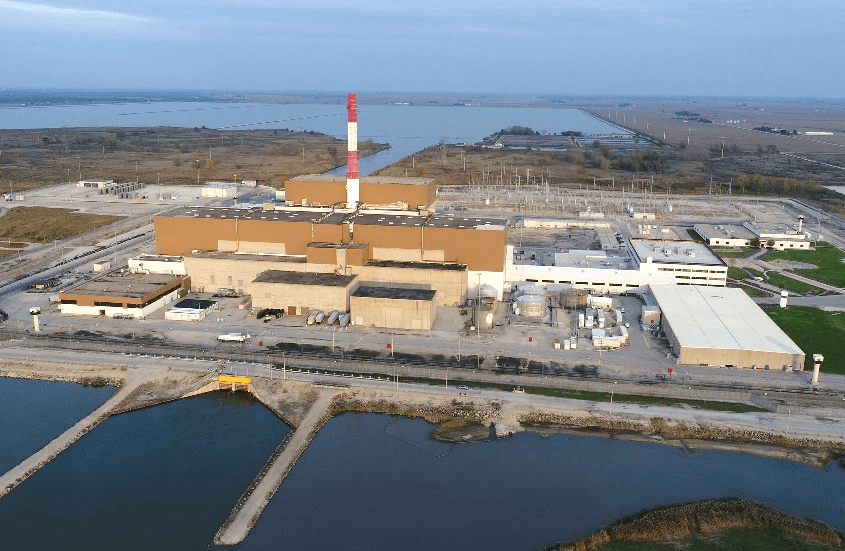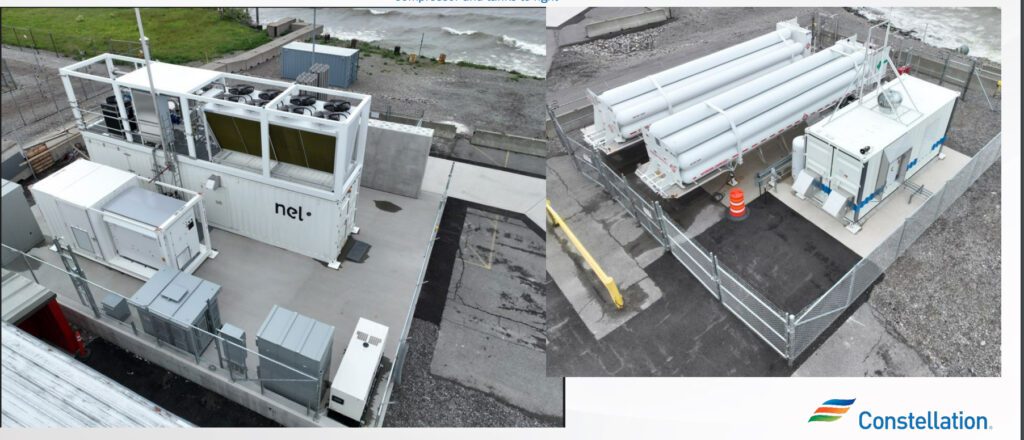Constellation Planning Significant Nuclear-Powered Hydrogen Facility at LaSalle
Constellation Energy will use a portion of newly announced federal funding for the Midwest Hydrogen Hub (MachH2) to build “the world’s largest nuclear-powered clean hydrogen facility” at its 2.3-GW LaSalle Clean Energy Center in Illinois.
The company on Oct. 16 said it plans to leverage a $1 billion award announced by the Department of Energy (DOE) last week for MachH2—a massive hydrogen hub that will integrate projects in several Midwestern states—to produce an estimated 33,450 tons of clean hydrogen each year at LaSalle, its giant nuclear plant in Marseilles, Illinois. The hydrogen hub award, allocated in the November 2021–enacted Infrastructure Investment and Jobs Act, could “offset” LaSalle’s estimated $900 million costs for the nuclear hydrogen project, it said.
The project’s timeframe, however, is unclear and may be determined as the MachH2 alliance completes negotiations with DOE to finalize details and conditions of the award, the company suggested. As POWER has reported, the DOE expects its selected hubs will be executed over a broad timeframe of about 8 to 12 years or sooner, depending on their size and complexity.
Constellation on Monday also suggested the project may be contingent on federal guidance from the U.S. Treasury that could clarify how hydrogen suppliers will qualify for tax credits of as much as $3/kilogram (kg), as outlined in the August 2022–enacted Inflation Reduction Act. “In the months leading up to this selection, Constellation, organized labor partners and business leaders have urged the administration to provide important guidance implementing Congress’ intention to allow hydrogen production using carbon-free power from existing nuclear stations to earn tax credits contained in the Inflation Reduction Act,” noted Joe Dominguez, Constellation president and CEO, on Monday. “Without those credits, projects like this one will not go forward.”
Dominguez, however, suggested the DOE’s hydrogen hub awards unveiled last week mark a positive step. “Today’s award is proof positive that DOE and the administration want existing nuclear energy to play a vital role in jumpstarting domestic hydrogen production and we look forward to final Treasury Department guidance,” he said.

Banking on Nine Mile Point’s Pioneering Nuclear Hydrogen Demonstration
Constellation, which is currently the largest producer of nuclear energy in the U.S., on Monday noted it plans to “employ lessons learned” from Constellation’s 1-MW nuclear hydrogen demonstration at its 1.9-GW Nine Mile Point nuclear plant in Oswego, New York, to build the LaSalle facility. The pilot demonstration began producing 531 kilograms (kg) per day of hydrogen in March using a Hydrogen Generation System proton exchange membrane (PEM) electrolyzer, which was manufactured by Nel Hydrogen.
The demonstration, the first of several significant efforts around the U.S. to examine how nuclear hydrogen can be feasibly integrated into the wider energy market, officially kicked off in July 2021. Along with seeking to verify steady-state in-house hydrogen production, a key project objective has been to simulate a scaled-up operation of a larger electrolyzer’s participation in power markets.
Cost forecasts for the Nine Mile Point pilot demonstration hover at about $14.4 million, Constellation has said. The pilot leverages a $5.8 million DOE award that supported the construction and installation of its low-temperature electrolysis system. A separate $12.5 million award from the New York State Energy Research and Development Authority (NYSERDA) bolsters a “follow-on” project to install a fuel cell at the facility. That project, expected to start up in 2025, could allow the system to use the excess capacity from its electrolyzer to store long-duration energy and put it back onto the grid during peak demand conditions.
The pilot, notably, also received technical backing from the Idaho National Laboratory and Argonne National Laboratory, which developed a front-end controller and oversaw the dynamic operation of its prototype electrolyzer. The National Renewable Energy Laboratory provided analysis for scaled-up hydrogen production and hydrogen market analysis.
During a July 2023 DOE-hosted webinar, Nine Mile Point Pilot Demonstration Project Manager Robert Beaumont said the project has so far achieved key milestones “just under budget.” The project, he said, was initially conceived to bolster its bottom line by producing its own hydrogen for in-house consumption. The pilot, however, also promised to demonstrate the “dynamic operation” of its electrolyzer, enabling remote control of the electrolyzer to ramp it up and down in response to grid conditions.
Nine Mile Point uses “a fair amount” of hydrogen onsite for its boiling water reactors, most of which was previously “trucked in” from the Philadelphia area, Beaumont noted. “We add hydrogen into the nuclear core, and that helps alleviate any oxygen inside the core area and reduces corrosion inside the core,” he said. By making its own hydrogen, the nuclear plant effectively provides an “economic supply of in-house hydrogen for consumption,” he said.
Currently, the plant uses 15% of its produced hydrogen—of 531 kg/day—“continuously to support the plant,” he noted. “The larger electrolyzer gives us the ability to operate dynamically and go to charging,” which involves filling two containerized tube trailers. “If I charge for four hours a day, then I can turn the system off and run from the trailers for the remaining 20 hours a day,” he said.
The native output of the electrolyzer is “somewhere around 400 PSI, plus or minus 30,” Beaumont noted. “Our hydrogen system likes to use this pressure at about 250 pounds per square inch, and that’s so the electrolyzer can feed directly as needed just by going through a pressure reduction system,” he added. “When we go to storage, we compress from that 400 pounds up to about 2,200 pounds. And that’s based on the storage that we’re allowed to have as part of our blast calculation for the hydrogen storage trailers and their location.”
Unveiling Real-World Hurdles
Still, development of the first-of-its-kind project entailed several considerations, such as determining criteria for the best site to place the electrolyzer. “The power comes off the generator at about 25,000 V, and it then goes through a transformer that supplies power to the nuclear power station itself,” stepped down to about 13,800 V, Beaumont said. “We hook the electrolyzer up to that 13,800-V bus, and we ran the cable across the site to go to the electrolyzer.” In total, Nine Mile utilizes 1.25 MW for the electrolyzer stack to produce hydrogen at full output, and another 250 kW for the electrolyzer’s auxiliary pumps, motors, compressor motors, and cooling systems.

The team’s early development work also involved pinning down regulatory limitations, including from the Nuclear Regulatory Commission (NRC), the North American Reliability Corp., the New York Independent System Operator, New York state regulators, and the Environmental Protection Agency. “As part of those decisions, we chose to put the system outside our protected area and away from any of our safety systems,” he said.
The project’s 100% site-specific final engineering design was wrapped up in February 2022, and the national laboratories completed an economic feasibility assessment for the scale-up at the end of 2022. “We started full operation on March 7 of this year, and we’ve been supplying the plant since then,” Beaumont said.
“We’ve shown that the compressor can work off-peak and fill at the interim storage tanks, run off the storage tanks during peak loads, and then continue to charge during off-peak times,” he noted. “We’ve also shown that we can operate continuously with low power usage continuously, and we’re still evaluating which is going to be better for the operation of the plant.”
But the pilot also gleaned key learnings. It led, for example, to a refined compressor factory acceptance testing, and the development of specialized valve seal materials that could stand up to freezing temperature conditions in upstate New York, he said. The project was also compounded by supply chain disruptions, including those stemming from the COVID-19 pandemic and the conflict in Ukraine, which affected European components.
According to Beaumont, the project continues to explore nuclear hydrogen’s wider prospects for system integration. “In future work, we’ll continue to demonstrate the dynamic operation on the site and come up with the optimum, balancing both the economics and the operational conditions to determine how we’re going to operate the system long-term,” he said.
—Sonal Patel is a POWER senior associate editor (@sonalcpatel, @POWERmagazine).